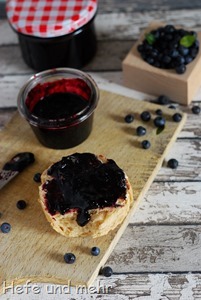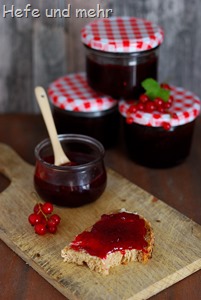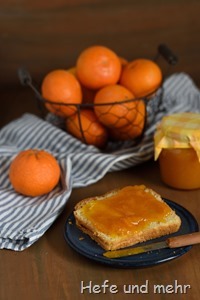 This is already the third batch of this orange marmalade I cooked in the last month. Partly because the marmalade is so delicious and partly because I tweaked every batch a bit more until I reached a state of perfection (at least for me). The idea of cooking and then pureeing whole oranges I took form Christine Ferbers “Jam bible”. And already the first batch made after her recipe was great. But the bitterness was a bit to strong for me and so I started to tweak. I changed the time for cooking and the ratio of juice and whole fruits.
This is already the third batch of this orange marmalade I cooked in the last month. Partly because the marmalade is so delicious and partly because I tweaked every batch a bit more until I reached a state of perfection (at least for me). The idea of cooking and then pureeing whole oranges I took form Christine Ferbers “Jam bible”. And already the first batch made after her recipe was great. But the bitterness was a bit to strong for me and so I started to tweak. I changed the time for cooking and the ratio of juice and whole fruits.
And I tested different kinds of oranges. My favourite is the Canoneta, but every juice orange is a good choose as the mesocarp (the white thing between rind and fruit) is thinner and so the marmalade is less bitter. But if you can get tangrin I can only highly recommend to add some to the mixture, too. They add a deepness of flavour that is incomparable.
And so the third batch is now a big candidate for the title “Favourite Jam of 2017” and in combination with freshly baked brioche it can replace every cake for me.

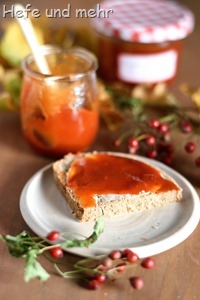 Whenever I snack tiny spoonful of the delicious rosehip jam, I close my eyes and remember sunlit wild rosebushes on beautiful morning in October. While around our home there are only few bushes with small fruits, in Swabia you can find a lot beautiful fruits. And so we used our saturday morning stroll to pick some fruits. With four people more then a kilogram is fast picked.
Whenever I snack tiny spoonful of the delicious rosehip jam, I close my eyes and remember sunlit wild rosebushes on beautiful morning in October. While around our home there are only few bushes with small fruits, in Swabia you can find a lot beautiful fruits. And so we used our saturday morning stroll to pick some fruits. With four people more then a kilogram is fast picked.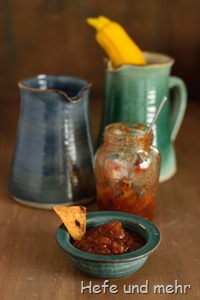 Some recipes have to be made in big batches as they are favourites. The summer squash salsa from Irmela Erckenbrechts cookbook “Zucchini” is a such a family favourite. It taste great as spread on fresh bread, as dip for nachos, as barbeque sauce or as fast dinner with pasta. And so we normally quadruple the amount given in the book directly.
Some recipes have to be made in big batches as they are favourites. The summer squash salsa from Irmela Erckenbrechts cookbook “Zucchini” is a such a family favourite. It taste great as spread on fresh bread, as dip for nachos, as barbeque sauce or as fast dinner with pasta. And so we normally quadruple the amount given in the book directly.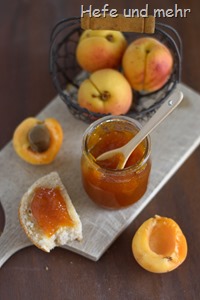
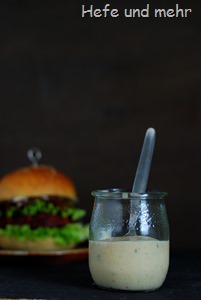 For a good start in our weekend I cooked some delicious burgers. And making burgers means always preparing everything fresh, from bun to the patty and the sauce. Add something special, I decided to make a honey mustard sauce.
For a good start in our weekend I cooked some delicious burgers. And making burgers means always preparing everything fresh, from bun to the patty and the sauce. Add something special, I decided to make a honey mustard sauce.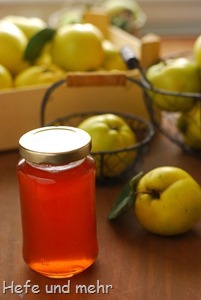 When the quinces turn golden in my parents garden then we are in the middle of autumn. And our flat is filled with the rich perfume of the fruits as I tend to place them strategically in living room and kitchen to enjoy my favourite autumn flavour as much as possible.
When the quinces turn golden in my parents garden then we are in the middle of autumn. And our flat is filled with the rich perfume of the fruits as I tend to place them strategically in living room and kitchen to enjoy my favourite autumn flavour as much as possible.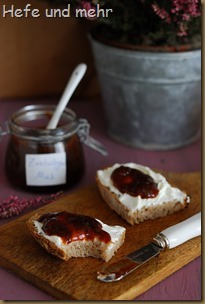 Since three years I use my Slowcooker to cook plum butter. This is very relaxed as I just have to remove the plum pits the night before and turn on the slow cooker. I put the lid on the cooker in a right angle, leaving a gap so the evaporated water can escape. After 12 hours cooking on “High” the juice has reduced a good deal and after pureeing it needs another three to four hours until it reaches the perfect thick consistence.
Since three years I use my Slowcooker to cook plum butter. This is very relaxed as I just have to remove the plum pits the night before and turn on the slow cooker. I put the lid on the cooker in a right angle, leaving a gap so the evaporated water can escape. After 12 hours cooking on “High” the juice has reduced a good deal and after pureeing it needs another three to four hours until it reaches the perfect thick consistence.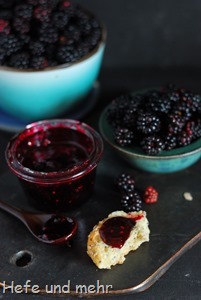 The sunny and hot days of the last week turns the first blackberries into dark and delicious treats. And so we went to pick berries early on Saturday morning . Natures plenty was very overwhelming and in little more then an hour we picked three kilogram. And because I read Christine Ferbers “Marmeladenbibel” we picked some red, unripe blackberries as well. The reason for this the fact that blackberries contain less pectin then red currants or blueberries. Adding some unripe fruits increase the pectin content because they contain much more pectin then ripe fruits. They add some acidity as well which support the gelling process as well.
The sunny and hot days of the last week turns the first blackberries into dark and delicious treats. And so we went to pick berries early on Saturday morning . Natures plenty was very overwhelming and in little more then an hour we picked three kilogram. And because I read Christine Ferbers “Marmeladenbibel” we picked some red, unripe blackberries as well. The reason for this the fact that blackberries contain less pectin then red currants or blueberries. Adding some unripe fruits increase the pectin content because they contain much more pectin then ripe fruits. They add some acidity as well which support the gelling process as well.